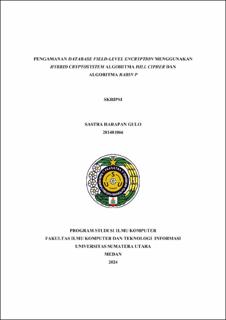| dc.description.abstract | Data security in databases is crucial to prevent unauthorized parties from viewing, accessing, and manipulating the data. Cryptography algorithms are required to secure the data in the database to make it incomprehensible. The Hill Cipher algorithm is a symmetric algorithm that is advantageous due to its speed in the encryption and decryption processes but is weak against known-plaintext attacks. Therefore, field-level encryption is necessary to ensure each row of data in the database has a different encryption key, which complicates key management. The Rabin P algorithm, an asymmetric algorithm, offers high security but generates ciphertext several times longer than the plaintext. A Hybrid Cryptosystem combines symmetric and asymmetric algorithms, leveraging their respective strengths. The Hill Cipher algorithm key for data encryption is generated using Blum-Blum-Shub. In the encryption process with the Hybrid Cryptosystem, the Hill Cipher algorithm, the Rabin P algorithm, and the Blum-Blum-Shub random number generator successfully secure the data in the database, making it incomprehensible and ensuring that the encryption keys are different for each row of data and encrypted. The decryption process can return the encrypted data to its original form without any data loss. The time required for encryption and decryption is directly proportional to the number of characters. Key renewal for the Rabin P algorithm is performed by decrypting the data (ciphertext) using the old key and then re-encrypting the data (plaintext) using the new key. | en_US |


